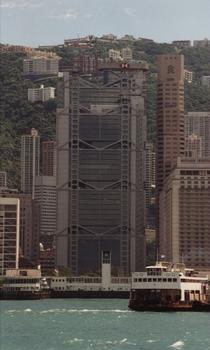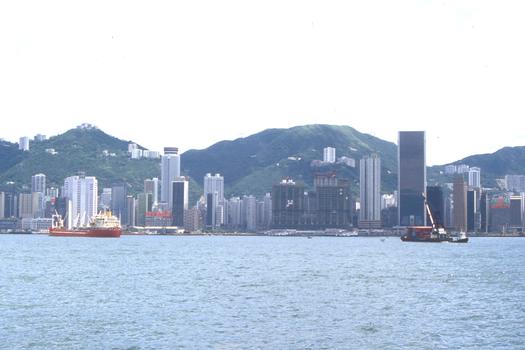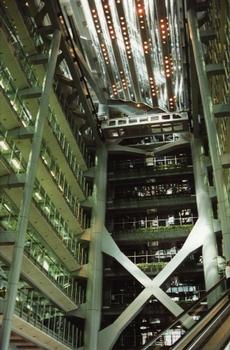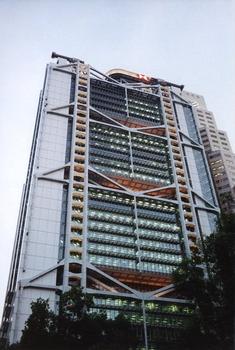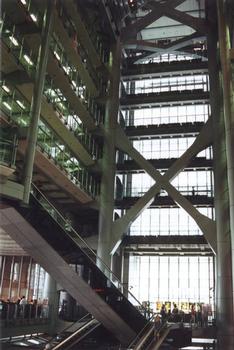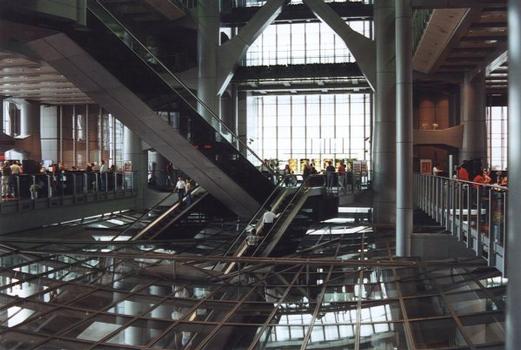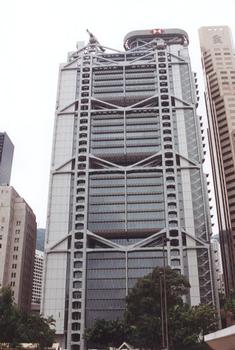General Information
| Other name(s): | Hong Kong and Shanghai Bank Building |
|---|---|
| Beginning of works: | 1983 |
| Completion: | 18 November 1985 |
| Status: | in use |
Project Type
| Function / usage: |
Office building |
|---|---|
| Material: |
Steel structure |
| Architectural style: |
High-tech |
Location
| Location: |
Central, Central and Western, Hong Kong, China |
|---|---|
| Address: | 1 Queen's Road |
| Coordinates: | 22° 16' 49.01" N 114° 9' 34.34" E |
Technical Information
Dimensions
| height | 178.8 m |
Materials
| building structure |
steel
|
|---|
Excerpt from Wikipedia
HSBC Main Building is a headquarters building of The Hongkong and Shanghai Banking Corporation, which is today a wholly-owned subsidiary of London-based HSBC Holdings. It is located on the southern side of Statue Square near the location of the old City Hall, Hong Kong (built in 1869, demolished in 1933). The previous HSBC building was built in 1935 and pulled down to make way for the current building. The address remains as 1 Queen's Road Central (the north-facing side of the building was served by Des Voeux Road, which was the seashore, making Queen's Road the main entrance, in contrast to the current primary access coming from Des Voeux Road). The building can be reached from Exit K of Central MTR station.
History
The first building on the left is Wardley House, used as an office by HSBC between 1865 and 1882, was located next to the coastline on Des Voeux Road First building
The first HSBC (then known as the Hong Kong and Shanghai Banking Company Limited) building was Wardley House, used as an HSBC office between 1865 and 1882 on the present site. In 1864 the lease cost HKD 500 a month. After raising a capital of HKD 5 million, the bank opened its doors in 1865.
Wardley House was subsequently demolished and replaced by a second HSBC building that was completed in 1886. The main feature of the second building design was the division of the structure into two almost separate buildings. The building on Queen's Road Central was in Victorian style with a verandah, colonnades and an octagonal dome, whereas an arcade which harmonised with the adjacent buildings was constructed on Des Voeux Road. It was designed by Clement Palmer in 1883.
In 1934, the second building was demolished and a third design was erected. The new building opened in October 1935. Upon completion, the building stood as the tallest building in Hong Kong. The third design used part of the land of the old City Hall, and was built in a mixed Art Deco and Stripped Classical style. During the Japanese occupation of Hong Kong, the building served as the government headquarters. It was the first building in Hong Kong to be fully air-conditioned. By the 1970s, the bank had outgrown its headquarters; departments were scattered into offices all over Central, and it was obvious that such a "solution" to the space limitations could not continue indefinitely. In 1978, the bank decided to tear down its headquarters and construct a new, larger headquarters building.
The new building was finished on 18 November 1985. At the time, it was the most expensive building in the world (c.a.HK$5.2 billion, roughly US$668 million).
The first major addition to the building, designed by Hong Kong's One Space Ltd, was completed on 23 November 2006, in the form of a ground floor lobby that improves security access to the upper floors and creates a prestigious reception area. Its design and construction included the installation of the "Asian Story Wall", a multimedia installation consisting of twin banks of 30 seamless plasma screens (the largest installation of its kind in Hong Kong) displaying archived bank heritage and artworks.
The atrium of the HSBC building was the site of the Occupy Hong Kong protests which maintained a presence in the building from 15 October 2011 until their eviction in September 2012.
Design
The new building was designed by the British architect Norman Foster and civil & structural engineers Ove Arup & Partners with service design by J. Roger Preston & Partners. It was constructed by the John Lok / Wimpey Joint Venture. From the concept to completion, it took seven years (1978–1985). The building is 180 metres high with 47 storeys and four basement levels. The building has a modular design consisting of five steel modules prefabricated in the UK by Scott Lithgow Shipbuilders near Glasgow, and shipped to Hong Kong. About 30,000 tons of steel and 4,500 tons of aluminium were used.
The original design was heavily inspired by the Douglas Gilling designed Qantas International Centre in Sydney (currently known as Suncorp Place).
The new lobby and its two-part Asian Story Wall were designed by Greg Pearce, of One Space Limited. Pearce was also the Principal Architect of the Hong Kong Airport Express (MTR) station. Conceived as a minimalist glass envelope, the new lobby is designed to be deferential to Foster's structure and appears almost to be part of the original.
The building is also one of the few to not have lifts as the primary carrier of building traffic. Instead, lifts only stop every few floors, and floors are interconnected by escalators.
Characteristics
The main characteristic of HSBC Hong Kong headquarters is its absence of internal supporting structure.
Another notable feature is that natural sunlight is the major source of lighting inside the building. There is a bank of giant mirrors at the top of the atrium, which can reflect natural sunlight into the atrium and hence down into the plaza. Through the use of natural sunlight, this design helps to conserve energy. Additionally, sunshades are provided on the external facades to block direct sunlight going into the building and to reduce heat gain. Instead of freshwater, seawater is used as a coolant for the air-conditioning system.
All flooring is made from lightweight movable panels, under which lies a comprehensive network of power, telecommunication, and air-conditioning systems. This design was to allow equipment such as computer terminals to be installed quickly and easily.
Because of the urgency to finish the project, the construction of the building relied heavily on off-site prefabrication; components were manufactured all over the world. For example, the structural steel came from Britain; the glass, aluminium cladding, and flooring came from the United States while the service modules came from Japan.
The inverted 'va' segments of the suspension trusses spanning the construction at double-height levels is the most obvious characteristic of the building. It consists of eight groups of four aluminium-clad steel columns which ascend from the foundations up through the core structure, and five levels of triangular suspension trusses which are locked into these masts.
Feng shui
HSBC installed two "cannons" on the roof, pointing directly at the Bank of China Tower, allegedly to balance the negative feng shui energy directed at it.
The early British settlers in Hong Kong had an interest in feng shui; thus, most of the earliest buildings in Hong Kong, and many buildings constructed thereafter, were built with the philosophies of feng shui in mind. The Chinese believe that those who have a direct view of a body of water—whether it is a river, a sea, or an ocean—are more likely to prosper than those who do not (water is strongly associated with wealth in feng shui). The HSBC building has a wide open area (the Statue Square) in front of it, with no other buildings blocking its view of Victoria Harbour; thus, it is considered to have "good feng shui".
In the CBC Television series Doc Zone episode "Superstitious Minds", Writer, Researcher & Associate Producer Tom Puchniak asserts that the design of the nearby Bank of China Tower ignored feng shui principles, and created instant controversy by evoking two knife edges, one pointing towards the British Government House, another towards the HSBC building. After the Bank of China building opened, a series of mishaps occurred, including the death of the Governor, and a downturn in the city's economy. It is alleged that HSBC installed two maintenance cranes in the shape of cannons on the roof, pointing directly at the Bank of China, to defend against the negative energy from the Bank of China building. According to feng shui master Paul Hung, this solved the problem, and HSBC experienced "no harmful results after that."
Lighting scheme
In 2003, the Hong Kong Tourism Board developed a harbour lighting plan called "A Symphony of Lights", a large-scale multimedia show featuring lighting, laser, music, and occasionally special pyrotechnics effects during festivals, to promote tourism in Hong Kong. The show is based on the illumination of key buildings on the Hong Kong Island side, and is best viewed from the Kowloon side across the Victoria Harbour. The HSBC Hong Kong headquarters building is one of the participating buildings in the show. The building has been installed with 716 intelligent lighting units, including 450 Martin Professional Cyclo 03 colour changing fluorescent fixtures in the glass stairwells, Martin Professional Exterior 600's and Exterior 200 fixtures on five levels, 8 search lights, and over one kilometre of LED lighting around the top. Completed by mid-December 2003, the cost of installation is estimated to be HK$5.5 million.
Intelligent lighting is distributed across six sections of the building:
- Vertical Ladder Trusses
- Exoskeleton: Inner + Outer
- Refuge Floors
- Northwest Stairwell
- Eastern Stairwells
- Roof Building Maintenance Units
HSBC has always aimed to adopt a new lighting scheme because Foster did not pay much attention to the illumination of the building at nighttime.
Text imported from Wikipedia article "HSBC Building (Hong Kong)" and modified on March 2, 2021 according to the CC-BY-SA 4.0 International license.
Participants
-
Foster and Partners
- Norman Foster (architect)
Relevant Web Sites
Relevant Publications
- (1986): The Basements and Substructure for the New Headquarters of the Hongkong and Shanghai Banking Corporation, Hong Kong. In: Proceedings of the Institution of Civil Engineers, v. 80, n. 4 (August 1986), pp. 851-883.
- (2001): Foster Catalogue 2001. Prestel, pp. 240.
- (1988): Hongkong and Shanghai Banking Corporation Headquarters Construction. In: Proceedings of the Institution of Civil Engineers, v. 84, n. 1 (February 1988), pp. 43-65.
- (2001): Horizons architecture / Architectural Horizons. 50 bâtiments et ouvrages d'art dans le monde. Editions Le Moniteur, Paris (France), pp. 256.
- (1994): Norman Foster. Éditions Hazan, Paris (France), pp. 54-57, 66-93.
- About this
data sheet - Structure-ID
20000037 - Published on:
28/10/1998 - Last updated on:
28/07/2014

